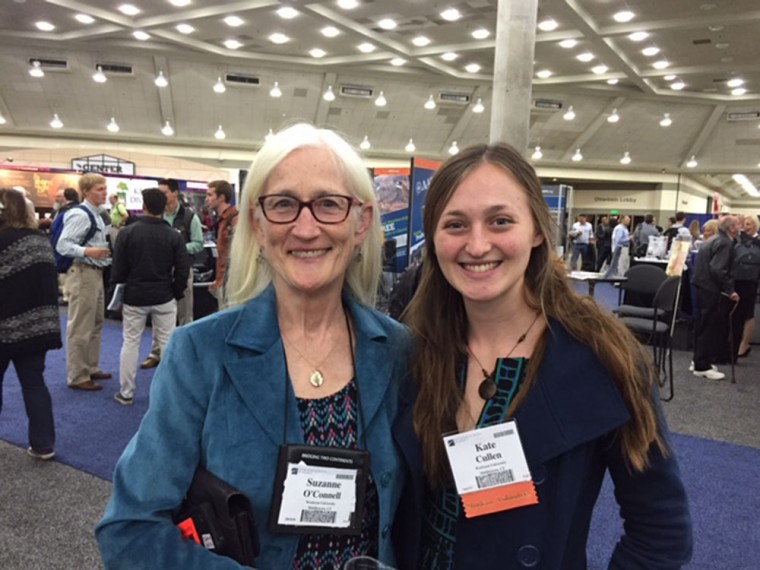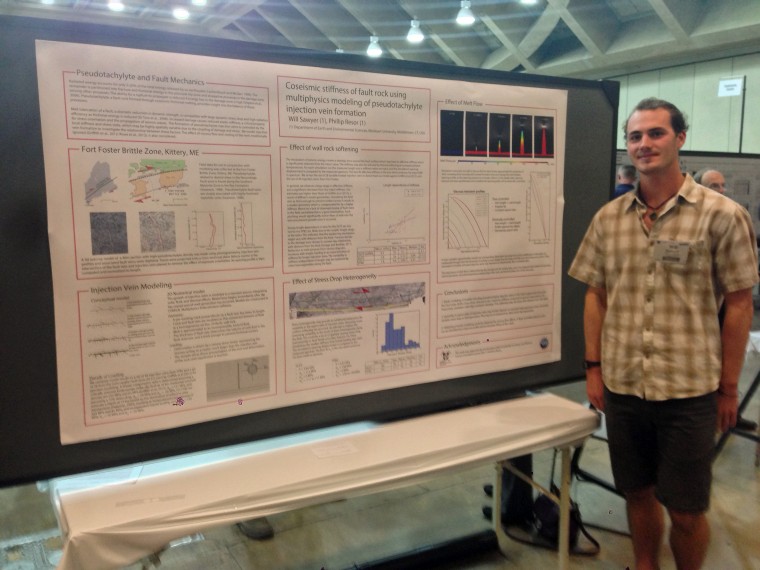E&ES Faculty, Students Contribute to GSA Annual Meeting


Wesleyan Earth and Environmental Sciences students and faculty attended and contributed to this year’s Geological Society of America (GSA) Annual Meeting, held Nov. 1–4 in Baltimore, Md.
At the event, Suzanne O’Connell, professor of earth and environmental sciences and faculty director of the McNair Program, received the Exchange Award from the Association for Women Geoscientists. She was recently inducted as a Fellow of GSA. O’Connell was also co-organizer of three Pardee sessions celebrating the bicentennial of the 1815 publication of William Smith’s Map, “A Delineation of the Strata of England and Wales, with part of Scotland,” and attended both the Diversity Committee and Geology and Society Division meetings as past chair.
The event included many presentations by students and faculty, including:
- Lena Capece ’16 and Rebecca Hanschell ’16, The Twin Crater Lakes of Newberry Volcano, OR
- Kate Cullen ’16 and Zach Kaufman ’16, The Weddell Sea in the Pliocene: Interpreting the Sediment Record from ODP Site 697
- Joe Miligan MA ’16, Experimental Constraints on a New Leaf Gas-Exchange Method for Paleo-Co2 Reconstruction
- Will Sawyer ’16, Constraining Fault Zone Mechanics Using Multiphysics Modeling of Pseudotachylyte Injection Vein Formation
- Shaun Mahmood MA ’16, 3D-Printing Microfossils and New Jersey, a Most Habitable Place During an Asteroid Strike: Shocked Quartz and Iridium Spike Co-Occur Below a Maastrichtian Mollusk Community on the NJ Coastal Plain (co-author)
- O’Connell spoke about diversity in geosciences in Meeting the Challenge of Attracting Diverse Students to Geoscience
- Harold T. Stearns Professor of Earth Science Joop Varekamp presented his research findings from a summer Keck-funded program on the Newberry crater lakes in Oregon with Lena Capece ’16 and University Professor in the College of Integrative Sciences Ellen Thomas, also research professor in earth and environmental sciences, as co-authors of Carbon Cycling in Two Volcanic Lakes Fed by Geothermal Fluids: Photosynthetic Sequestration and Diffusive Co2 Escape. Varekamp also co-chaired an oral session and poster session titled “Lakes of the World.” He is chair-elect of the Geology and Public Policy Committee and chair of the Limnogeology division. Thomas also participated in committee meetings as editor of Geology and co-author on several other talks, including Biotic Response to Early Eocene Thermal Maximum 3 at Walvis Ridge, SE Atlantic Ocean, Benthic Foraminiferal I/Ca Records Indicate Dysoxia But Not Anoxia in the Late Paleocene–Early Eocene Oceans, and Using the Mollusc Fauna of the Atlantic Coastal Plain to Reconstruct Environmental Conditions Cross the Paleocene-Eocene Thermal Maximum (PETM), as well as the poster Workflow for Conserving and Digitizing Historic Microfossil Collections at the American Museum of Natural History.

Also in attendance were Phillip G. Resor, associate professor of earth and environmental sciences; Dana Royer, professor of earth and environmental sciences; and Alan M. Dachs Professor of Science Peter Patton.
Established in 1888, the Geological Society of America (GSA) provides access to elements that are essential to the professional growth of earth scientists at all levels of expertise and from all sectors: academic, government, business and industry. The society’s growing membership unites thousands of earth scientists from more than 115 countries in a common purpose to study the mysteries of our planet (and beyond) and share scientific findings.

